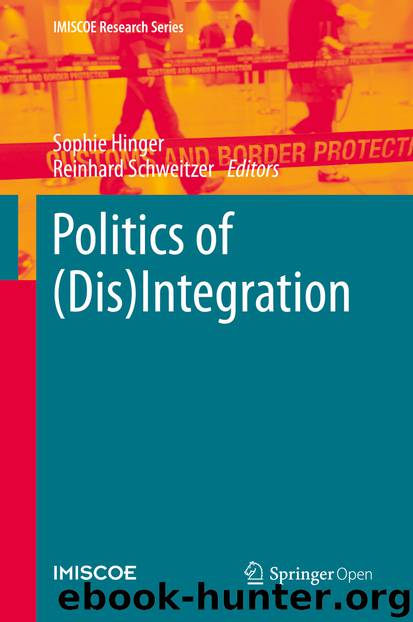Politics of (Dis)Integration by Unknown

Author:Unknown
Language: eng
Format: epub
ISBN: 9783030250898
Publisher: Springer International Publishing
6.4 Integration, Inclusion and Exclusion and Their Limitations
Despite some advantages in explaining inequalities, the dominant approaches to integration have several pitfalls. First, they implicitly assume and generalise a particular view on society and its desirable values. Beyond each approach about integration, there is an underlying moral meta-narration. It is assumed that ‘social inclusion or integration, as the opposite of social exclusion, is inherently good and desirable’ (Fangen et al. 2011, p. 2). Such an assumption, in turn, leads to a situation whereby attempts to integrate those perceived as socially excluded might turn out to be ‘problematic, disempowering or inequitable’ (2011, p. 2). To be more specific, the contemporary European policies of integration tend to narrow themselves to the issue of employment, reflecting the shift from welfare to ‘workfare’ policies, as shown, for example, by Sophie Hinger (2020).
Ruth Levitas (2005) argues that, despite differences in understanding what it means to be socially excluded or included (thus, integrated), the underlying assumptions of integration discourses stem from Durkheim’s understanding of society as organised around organic solidarity, with cohesion as its natural state (Durkheim 1997 [1893]). Both Durkheim and dominant discourses of integration share the assumption that ‘the individual identity as well as individual integration into society is primarily constituted through work’ (Levitas 2005, p. 181). Importantly, in both cases, work is understood narrowly as paid employment. Such a narrow understanding of work leads to the situation in which all those who exercise unpaid reproductive work are left aside or labelled as reluctant to work.
Second, the dichotomous view imposed by the basic opposition between the integrated and the excluded oversimplifies a very complex social reality and obscures the differences between those perceived as integrated. This has one further connotation, namely the language of exclusion shifts away from sight the class perspective and undermines the divergent, or sometimes even conflicting, interests of various groups.
Last but not least, the discussed approaches essentialise social reality, skipping the relational and processual aspects of the social position. This leads to the overlooking of both the life trajectories of individuals and the dynamic structural changes (e.g. in the employment patterns) which might shift the social position of entire groups.
From this perspective, exploring returning migrants’ experiences in terms of traditionally understood labour market integration would bring few results, as the analysis would boil down to the question of whether the returnee is employed or not. Therefore, bearing in mind the above-mentioned limitations of the integration discourse, yet acknowledging the possibility of returning migrants encountering various disadvantages on the labour market, the following issue arises: How should we approach and map the returnees’ labour experiences without imposing moral meta-narration, ignoring the spectre of individual and group (class) inequalities as well as essentialising?
In this chapter I propose to look at the returnees’ labour market (dis)integration through the lense of multi-segemented labour market theory (Loveridge and Mok 1979). According to this theory, the labour market is not homogenous and its model could be built around two continuous axes – the vertical or ‘social axis’
Download
This site does not store any files on its server. We only index and link to content provided by other sites. Please contact the content providers to delete copyright contents if any and email us, we'll remove relevant links or contents immediately.
Kathy Andrews Collection by Kathy Andrews(10521)
The remains of the day by Kazuo Ishiguro(7551)
Spare by Prince Harry The Duke of Sussex(4199)
Paper Towns by Green John(4169)
The Body: A Guide for Occupants by Bill Bryson(3802)
Be in a Treehouse by Pete Nelson(3214)
Harry Potter and the Goblet Of Fire by J.K. Rowling(3046)
Goodbye Paradise(2964)
Never by Ken Follett(2884)
Into Thin Air by Jon Krakauer(2703)
The Remains of the Day by Kazuo Ishiguro(2620)
The Genius of Japanese Carpentry by Azby Brown(2609)
The Cellar by Natasha Preston(2595)
Drawing Shortcuts: Developing Quick Drawing Skills Using Today's Technology by Leggitt Jim(2532)
120 Days of Sodom by Marquis de Sade(2439)
Architecture 101 by Nicole Bridge(2351)
The Man Who Died Twice by Richard Osman(2300)
Machine Learning at Scale with H2O by Gregory Keys | David Whiting(2293)
Fairy Tale by Stephen King(2072)
